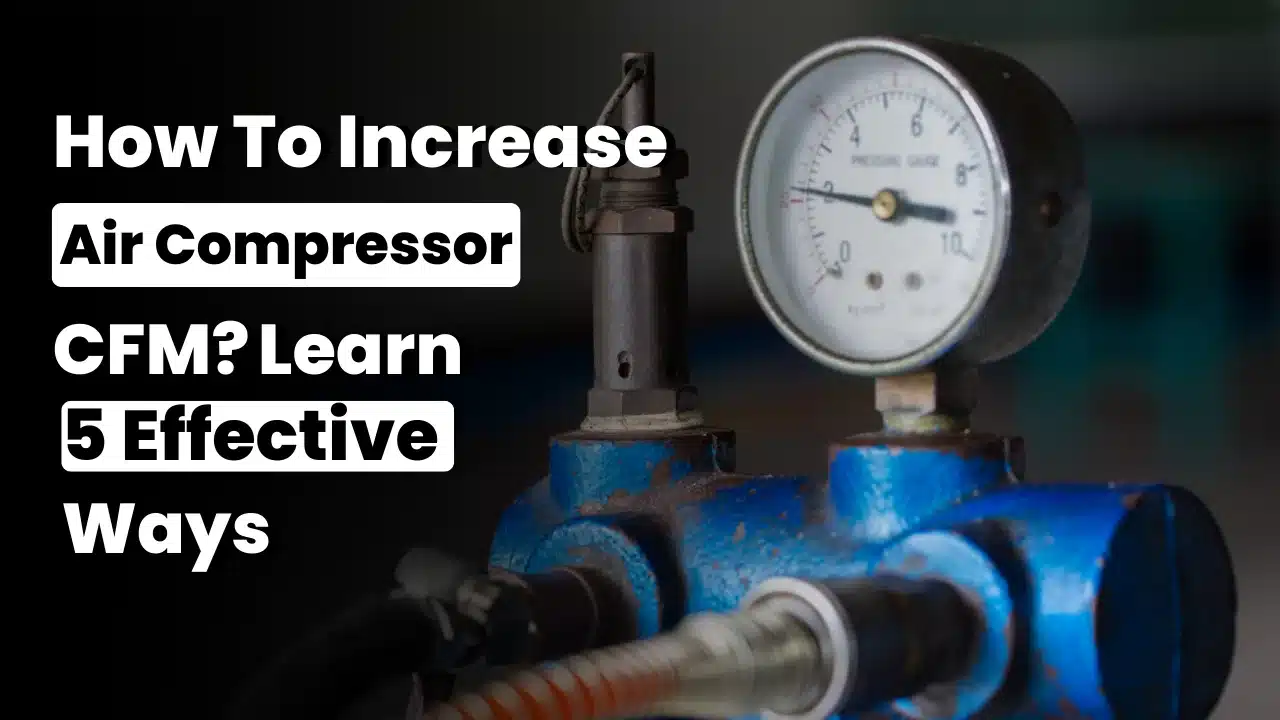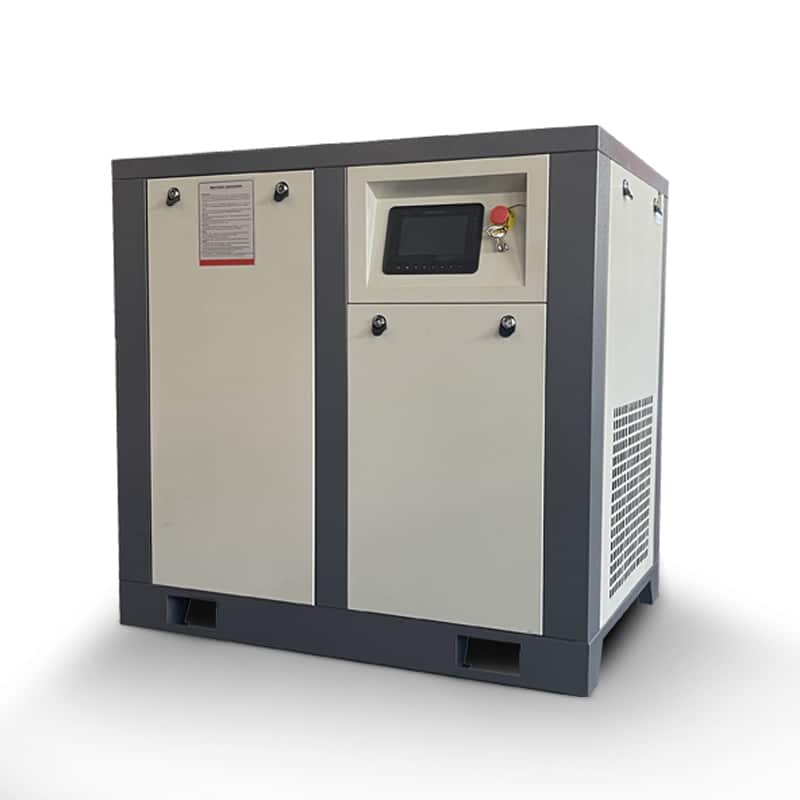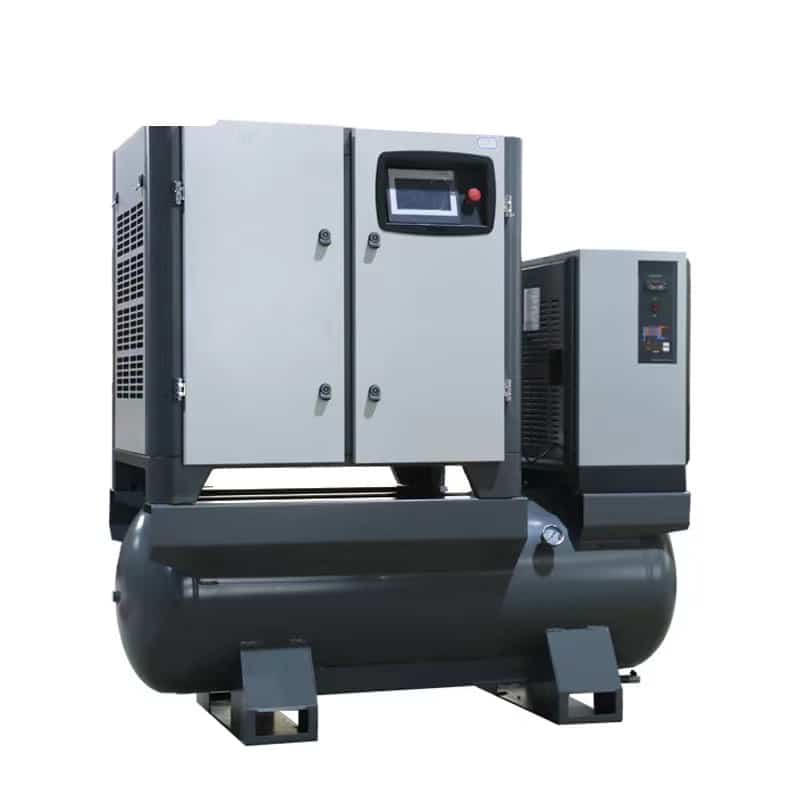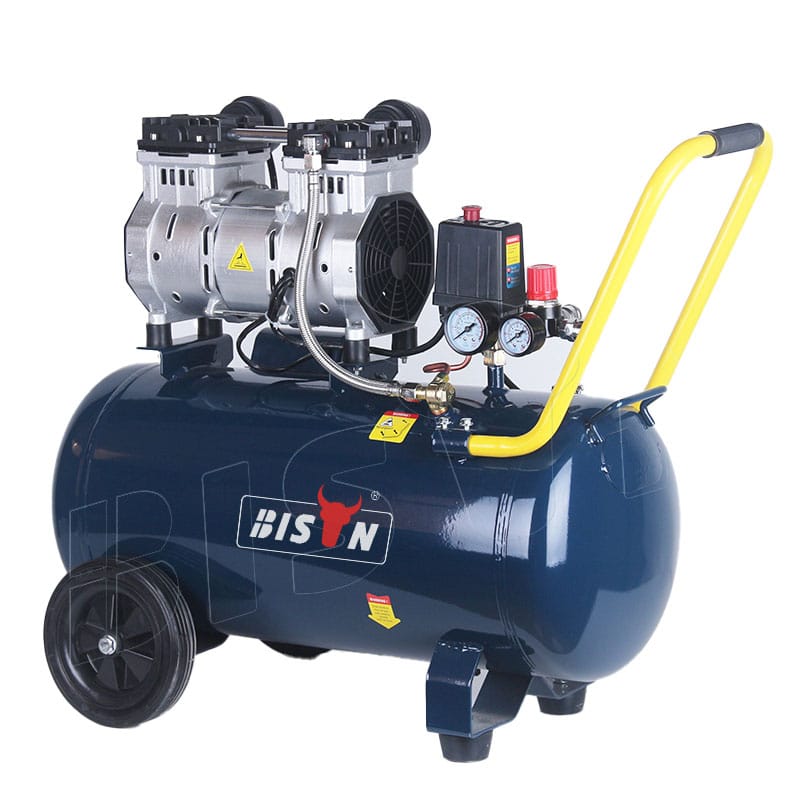air compressor blog
How to increase the CFM of the air compressor?
- Jun 7, 2023
The best way to increase the CFM of your air compressor is to make some adjustments to your system, such as adding another compressor pump or an air receiver tank for additional storage. To operate successfully, some tools require a CFM rating more significant than the air compressors.
Here you will find advice on adjusting the compressor to achieve the desired airflow rate (CFM).
How to get more CFM from your air compressor
To increase the CFM drawn from the air compressor outlet, you have two main options;
1. Increase the pumping capacity of the air compressor system,
2. Increase the air storage capacity of the system.
To be clear, none of these options will increase the inherent design specified CFM of the original compressor – this would require modifications to the pump.
but… You’re not interested in increasing the CFM of the compressor pump (what’s specified in the owner’s manual); what you’re interested in is increasing the CFM that can be drawn from the outlet of the air compressor tank – letting you run the specified job CFM higher than the compression machine pump for pneumatic tools.
We explain the concept of the CFM of the air compressor pump versus the CFM of the entire air compressor system in this article, explaining how to calculate the CFM of an air compressor system.
Whether to increase your air compression system’s pumping capacity or air storage capacity depends on whether your air tool’s air needs are intermittent or continuous.
Increasing CFM for cyclic or intermittent air tool use
If you have a short-term, intermittent, or periodic high demand for CFM but not continuous, you have more options for increasing CFM. Ultimately increasing the air storage capacity will allow you to increase the system’s CFM over time, depending on the air storage level.
Increasing CFM for continuous use of air tools
If you have a more continuous need for higher CFM (continuous running air tools), your compressor pump CFM will need to match the needs of your air tool. Therefore, adding additional air storage capacity to the system would not be appropriate. You would be limited to options for adding more pumping capacity (CFM) to the system.
Continuous and intermittent operation of air compressors
Whether the air tool connected to the compressor is for cyclical, intermittent or constant use, it is essential to note that your air compressor may be designed for “periodic operation”.
An air compressor will be designed for periods of operation (pumping) followed by periods of idling (cooling). This is called the air compressor duty cycle and is usually expressed as a percentage, such as 50% – this means the compressor needs to cool as much as it is running.
How to increase the CFM of an air compressor

Here are some of the best ways to increase the CFM of an air compressor.
1) Reducing the pressure to increase CFM
As air pressure builds up inside the air compressor, the outlet is pushed out at a specific flow rate (CFM – volume/time). Every compressor has rated power equal to pressure times CFM (airflow). Since you can’t quickly increase the compressor’s capacity past its limit, reducing system pressure by turning down the regulator will increase CFM – power remains the same.
If you are familiar with air compressors, you may have seen this option before looking for ways to increase the CFM of your air compressor. However, many compressor users must realize that your compressor outlet CFM varies based on the outlet pressure you set.
If you have a compressor rated at 4 CFM at 90 PSI, you can run a tool that requires a continuous CFM of 5 or even higher if the tool needs to work around 40 or 50 PSI.
This is because, at your air compressor tank outlet, there is an inverse relationship (within a specific range) between CFM and PSI.
So pay attention to your air tool’s CFM rating and operating pressure – it may be lower than 90 PSI to get an instant CFM boost from your existing compressor.
Considerations for reducing pressure to increase CFM
- Suitable for continuous use of air tools (as long as compressor CFM exceeds tool CFM needs)
- Ideal for intermittent use of air tools
- The most cost-effective solution – is to tune your compressor
It relies on your air tool having a sufficiently low operating pressure than 90 PSI (since CFM ratings are usually specified at 90 PSI)
The relationship between CFM and PSI is complex, so calculating the CFM your compressor can deliver at lower outlet pressures can be complicated and unreliable. Try to rely on something other than this method for significant increases in CFM (say more than 20-25%).
If the tool is to be used continuously, the CFM of the compressor at lower pressures still needs to exceed the CFM needs of the air tool.
Therefore, in continuous use, this method is limited to situations where the existing compressor can deliver the required CFM. Still, the outlet pressure is below the 90 PSI standard compressor CFM rating.
You can still use an underrated compressor in terms of CFM at lower pressures. If you are not continuously drawing higher CFM than your compressor pump can deliver, your compressor tank will act as a liquid reservoir allowing your compressor to “catch up” between Air tool usage cycles. But be careful not to exceed your air compressor duty cycle!
So even though this approach allows you to close the gap between your compressed air demand and what your compressor can supply, it may be sufficient for many cyclical air tool use applications.
2) Add another identical compressor to the system
Adding another compressor with the same CFM, make, and model can help double your current air compressor CFM rating without adding control complexity.
This approach increases the air compressor pumping system’s CFM while achieving a higher CFM at the air compressor tank/air pressure regulator outlet.
Once you have your replica air compressor, you can connect the two compressors using compressed air lines and an air T fitting. You can then plug your air tool or the airline leading to your air tool into the socket on the T-piece.
Since the air compressors are the same make, model and size, they have the same cut-in and cut-out pressure set on the pressure switch, which means no need for synchronous control issues… great!
Considerations for adding another compressor with a similar CFM
- Ideal for continuous-use air tool applications – higher CFM for air compressor systems
- Also suitable for intermittent air tool use
- Not cost-effective option
- The pressure switches should be the same, but manufacturing differences may mean that some adjustments may be needed to synchronize the pressure cut in and out
- You still need to check the duty cycle of the air compressor to properly size the air compressor according to the working CFM of the air tool.
If you don’t constantly need higher CFM, a duplicate air compressor may be a more aggressive way to increase CFM.
Applications such as operating air wrenches and framing nailers are examples of applications that require a high CFM-rated air compressor for continuous use.
3) Connecting two compressors of different CFM
Similar to the previous suggestion, but now focusing on connecting two air compressors of different CFM, make and model. It sounds easy. Not a process but an idea.
Connecting two compressors rated at 10 CFM and 5 CFM each will give you 15 CFM of continuous flow.
The process of connecting two compressors involves the following steps:
- Use the T-piece air fitting to connect the outlet of the air tank
- Connect the compressed air hose to the outlet of the T-piece
- Connect the air tool to an air hose
Considerations for connecting two compressors of different CFM
Ideal for continuous use of air tools – the system’s pumping capacity has a higher CFM
- Suitable for intermittent air tool use
- Not cost-effective because we need to purchase a new air compressor
- It might be a better deal if you use a spare compressor or borrow one from a friend or neighbor
- It will require an adjustable air compressor pressure switch
- You still need to check the duty cycle of the air compressor to properly size the air compressor according to the working CFM of the air tool
Controlling the cut-in of two different compressors
Operating two different compressors of different sizes, power, CFM, and even pressure can be tricky. The pressure switch for each compressor may be set to cut in at other pressures.
Now the compressors share a storage space (since their tanks are connected with hoses), and the pressure in the system will trigger each compressor to step in.
If one compressor is staged at 80 PSI and the other compressor is at 90 PSI, the second compressor will be staged once the system drops below 80 PSI – this will occur when the machine is working.
This is a control system issue – to prevent one compressor from doing all the work and ultimately producing the actual potential CFM of the system, you need to set the staging and cut-out pressures to be the same.
You must install adjustable pressure switches on both compressors and do manual work to get them in sync.
Adjust the pressure switch
It would help to consider the pressure switches on both compressors and whether they have similar cut-in and cut-out points. If so, they will work about the same, depending on the air needs of your air tool.
However, if the gap between the switches is too large, one compressor will do all the work, starting and stopping much more often. This will result in increased maintenance requirements and a possible shortened service life.
Also, this ends up lowering your peak CFM because peak CFM is reached when:
- The fuel tank is 99% full
- Both compressor pumps were running before shutting off
- If the system is 99% full and only the 10 CFM compressor is running, the actual peak CFM capacity equals the 10 CFM compressor plus the delivery capacity in the receiver tank.
However, when the system is 99% full, and both the 10 CFM and 5 CFM compressors are running – the peak CFM of the system is equal to 10 + 5 CFM plus the delivery capacity in the receiver tank.
4) Add another tank
Adding another air receiver will allow the air compressor to fill both tanks (one with the compressor + the other), giving you even more air storage. This means the air compressor motor will run longer before it reaches cut-off pressure and stops, allowing you to use the tool longer.
The compressor pump fills a larger volume, so you have more CFM due to a more extensive reservoir of pre-compressed air waiting to be used for high-demand air tools.
This is our favorite solution for increasing the CFM of your compressed air system.
We say “compressed air system” precisely because it is not correct to say that adding a second air receiver to the compressor increases “air compressor CFM” – that is if you understand “air compressor CFM” for “air compressor pump CFM”.
The CFM is available at the outlet of the compressed air tank (or air pressure regulator) and is separate from the CFM of the air compressor pump by having an air tank to store compressed air (within limits).
So even though the air compressor is rated for 5 CFM, we can get 15 CFM out of the air compressor system – we need a set of tanks big enough, and the 15 CFM is only available for a fixed period ——Because the air compressor pump cannot meet the demand.
Adding a second tank to the air compressor will give the compressor more time to cool (assuming you’re not drawing more CFM from the system than the compressor pump produces). This is because more air is now stored, so your air tool can run longer before the air tank drops below the cut-in pressure of the air compressor pump.
So it’s also a great way to help reduce stress on your air compressor – if it has a 50% duty cycle and spends 5 minutes on and 2 minutes off – you’re overstressed!
Considerations for adding another tank
Not suitable for continuous use of air tools (compressor will always catch up)
Ideal for intermittent use of air tools (the compressor has a chance to cool down)
Cost-effective, purchase another storage tank (instead of a whole new compressor)
Even intermittent use requires proper tank sizing.
The air compressor duty cycle still needs to be checked to properly size the air compressor based on the air tool operating CFM.
It is essential to ensure that your compressor is still operating within the limits of the duty cycle. Adding a tank to the system can reduce the on-time to idle time ratio, resulting in a reduced duty cycle, even though the pump is running longer.
5) Increase the size of existing compressor pumps and motors
Adding compressor pumps increases CFM, which you can call on constantly. Increasing the size of the motor does not necessarily increase the CFM since the pump is usually designed to use the specified motor size, so you end up with an oversized motor on a small pump.
Considerations for upsizing existing compressors
Depending on the age and size of your tank, retrofitting a new compressor pump and motor to an existing tank may be minimally cost-effective. In many cases, it may be more cost-effective to purchase a new, higher CFM compressor and the appropriate tank for your application.
Before making any changes, be vigilant in your research to ensure your air compressor can make these changes.
Frequently Asked Questions About How to increase the CFM of the air compressor?
Is the higher the CFM, the better the air compressor?
The higher the CFM of an air compressor, the more air it can deliver. Whether it's better depends on your application - if you're using heavy-duty air tools like impact wrenches or nail guns, then higher CFM is better, but if you're using more general tools, then high CFM may not be necessary.
What is a good CFM for an air compressor?
Good CFM depends on your tool requirements; specific air tools only require 0-5 CFM from a small portable air compressor at 90 PSI. On the other hand, more extensive tools may require an air compressor over 10 CFM.
Will the auxiliary tank increase the CFM?
It will increase the amount of CFM available (since you have more storage space to work longer), but it will not increase the pump CFM of the air compressor. To increase the CFM of a real air compressor, you need to increase the size of the pump/motor!
How to improve the performance of an air compressor?
To enhance the performance of your air compressor, you can:
- Improve air intake quality
- Perfect system design
- Determine the correct pressure required
- Minimize pressure drop
- Maintain your compressor
If you have any enquiries about the BISON air compressor, we would love to hear from you.










